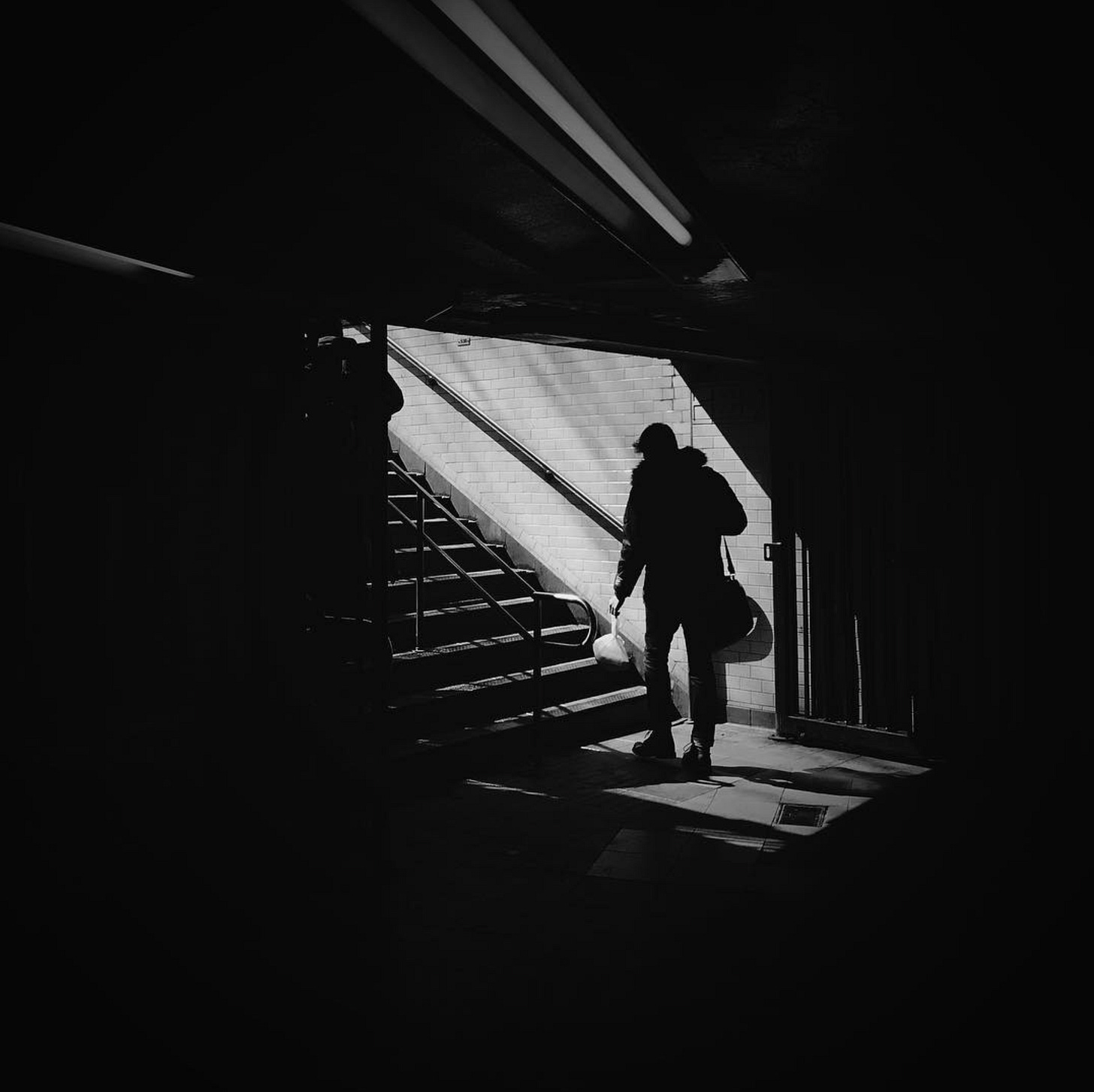Not Quite Here, Not Quite There
On liminal spaces, the in-between patches of the human landscape.

FOGELSVILLE, Pa.
I’M SITTING ON A PARK BENCH just outside the Sleep Inn in Fogelsville, Pennsylvania, one of my favored roadside motels, on a sunny Thursday morning in late August.
Before me is a tiny patch of lawn, a tree, and — just beyond a stubby little metal fence — the daunting on-ramp to Interstate 78 East. Cars fly by me in all directions, and giant trucks, too. As they pass, just a few feet away, the ground rumbles. The landscape feels like it could swallow me.
I am embedded, for this moment, in what we might call a “liminal space.”
What is a liminal space? It is an area that exists in between things — one that, for the most part, is not designed to be tarried in by human beings for very long. It is not here, nor is it there. Or maybe it’s both at once.
These way stations of our world are everywhere, and I have been exploring them in recent weeks, both geographically and in my head. This is because I am in a liminal moment of my own life right now, very much in between. So I thought to myself: Maybe I can make sense of this period — and navigate it more adeptly — by examining these kinds of spaces and trying to excavate what they might have to tell us.
We move through liminal spaces multiple times every day — from the waiting room in the dentist’s office to the bench on the street, from the train station platform to the departure lounge in the airport to the stairway up to your apartment to the little plastic enclosure where you wait for the bus.
LIMINAL SPACES FLIT AT THE EDGES of our consciousness, sometimes not identified as such, often not noticed at all. They are the landscape’s purgatories, and my instinct tells me there’s something to be learned from them.
This “parklet” outside the Sleep Inn, for example, where you can watch the I-78 on-ramp as if it’s a movie unfolding in front of you. It’s an example of a liminal space that has been commandeered into something non-liminal — something welcoming, even. It is an example of doing what you can with what you have. This Sleep Inn has the benefit of being located right by the convenient, fast-moving interstate, where it appeals to travelers (including me, who has stayed there probably three dozen times over the years). But it also has the detriment of being right by the impersonal, transitory interstate, and this diminutive park is doing the best it can.
Given where it sits, it is delightfully appealing — far more so than the clean, completely serviceable and entirely generic hallways just inside the motel. This appeal prevails despite — or perhaps because of — the overwhelming traffic noise that permeates the little park.

Amid the energy of transit that I'm seeing right now in six different directions as I sit, I feel strangely tranquil. This feeling floods over me even though I am reminded of the Dr. Seuss fable of the north-going Zax and the south-going Zax, whose irritation and intransigence causes them to stand, staring each other down, for years on end until a forbidding, cacophonous thicket of high-speed highways simply rises around them.
There is a beauty to sitting still in the middle of such bustle — to look out at the LANE ENDS MERGE LEFT sign and the YIELD sign and the unintentionally whimsical sign that warns you your truck might tip over by showing you a drawing of a truck tipping over.
This particular parklet at this particular Sleep Inn, I realize, has done something intriguing: It has taken something not designed for human consumption — at least, not for human consumption outside of a vehicle — and, with a bit of thought, has leveraged it into not only a vista but a place of peace where you wouldn’t think one would be.
I appreciate that. I think I've always appreciated that — the notion that things designed for function, not beauty, are sometimes able to be wrestled into beauty with just a park bench, a few rocks, a tiny patch of grass, and a sunny late-summer morning.
IF ALL THIS INTERESTS YOU, watch this space in coming weeks and months. Because I am officially declaring this an Unsorted but Significant™ topic. I will occasionally explore specific liminal spaces and try to see what meaning I can squeeze out of them.
Among the possibilities:
I spend quite a bit of time in New York City, and it occurred to me recently: All of Manhattan is kind of a liminal space — and a unique one at that. Because people’s living quarters there are generally so small, the city itself becomes their living rooms, their kitchens, their back yards, their front porches. And so liminal spaces — which are often (but not always) inhospitable in most places — become hospitable because in New York, to some extent, everyone spends a lot of their day in between things. This has produced some interesting locations that I hope to visit.
One of my great liminal loves (don’t judge) is Breezewood, Pennsylvania, once known as the “Town of Motels.” I have spent probably more than 150 nights there in my life, and in 1997 I spent an entire week there and wrote about it at great length. It is a mere sliver of its former self these days, with some of its motels empty or hollowed out, which actually makes it even more liminal. I’m going to go back and walk around.
I’ve found, and ordered, a book about “non-places” and will delve into that here at some point.
Sixty-five years ago, the fertile brain of Rod Serling came up with the ultimate liminal space — “The Twilight Zone.” In that show, he often presented episodes that took place in locales that weren’t quite here and weren’t quite there. I’ll write about how he framed that “land between” — and how its black-and-white identity helped shape my own view of what such spaces can entail.
If you take all this thinking to its extreme, you can even conclude that the entire world is a liminal space. We are, after all, just passing through as we make our way from one place to (many of us hope) another. I don’t intend to get quite that existential in this exploration. Or maybe I do. You’ve been warned.
I realize now that I’ve been gravitating toward — and lurking in — liminal spaces for much of my adult life and capturing them. Like the fabled Church on the Turnpike in Pennsylvania, for example, or the things you see behind houses and buildings as you pass them on train tracks. Tonight I looked back on my photos of the past 25 years from around the world and found no shortage of liminality. See below for a few of them. I’d be interested in what you think.
Each image shouted something, at least to me, in its own special way: that beauty does not have to be what we expect. That calm can be achieved in the middle of chaos, if you let it in. That sometimes, when we are in the throes of transit, be it physical or spiritual, we might actually be at our destination.
Most important, they shouted to me that possibility is everywhere — even in some of those twilight places where the welcome mat seems to be nowhere in sight. I’m hoping that understanding more about them might help guide me from where I’ve been to where I’m going — wherever that might be.




















Just re-tweeted your post and can't wait to read more entries on liminal spaces. Paul Lukas turned me onto you a few years ago, and his latest venture Inconspicuous Consumption along with your Substack posts are must reads here in our household. Thanks Ted!
What a project! What a quest! "I will occasionally explore specific liminal spaces and try to see what meaning I can squeeze out of them." So much of my curiosity in life has come from such places Mr.A.. I remember a moment in grade nine English class when we discussed losing ourselves in 'the middle distance'. This was a place where we gazed w/o seeing, an out of focus place, neither near nor far. A place in which we could wander in thought. Now, I like to call it creative staring, back then I remember it as a pivotal moment in understanding stuff.